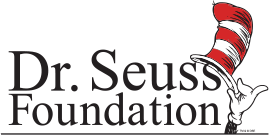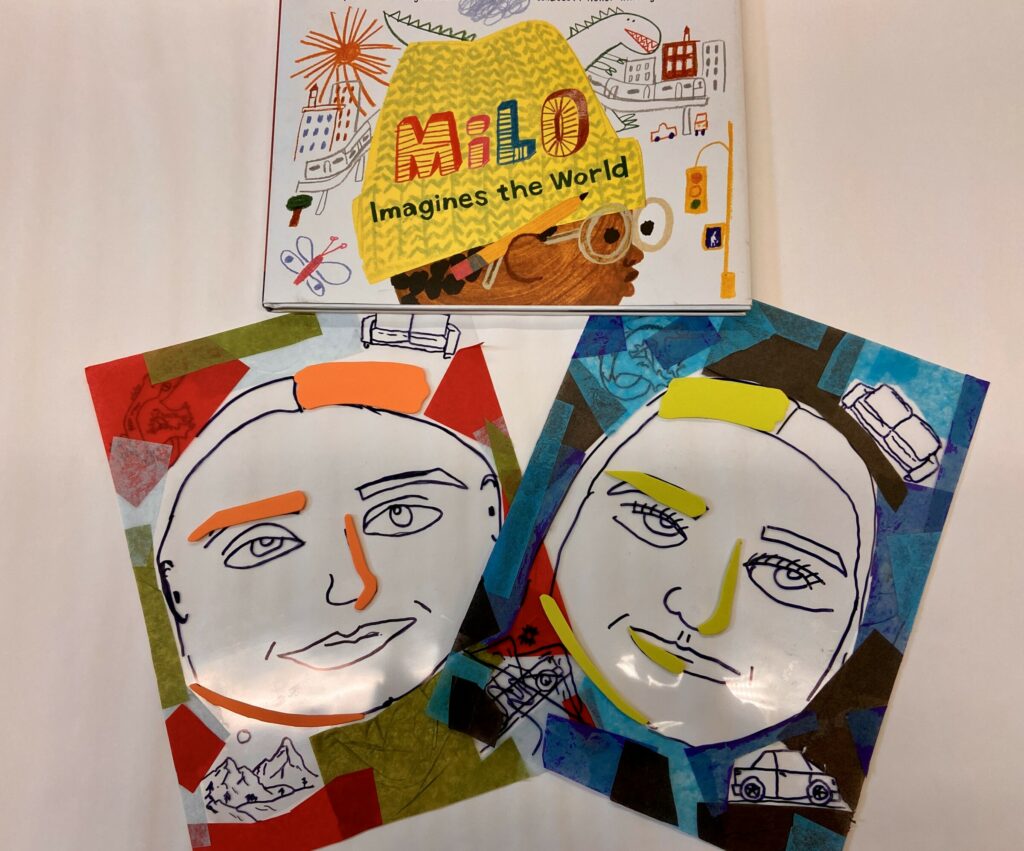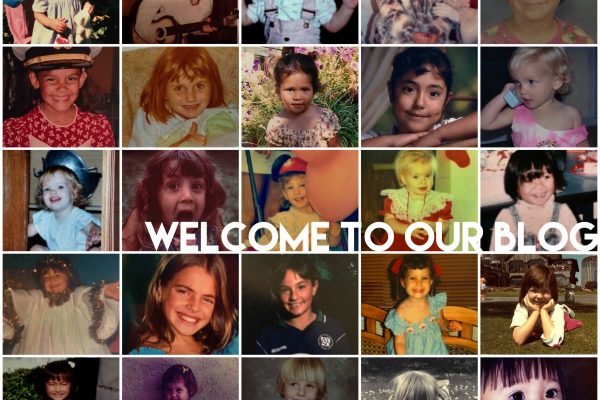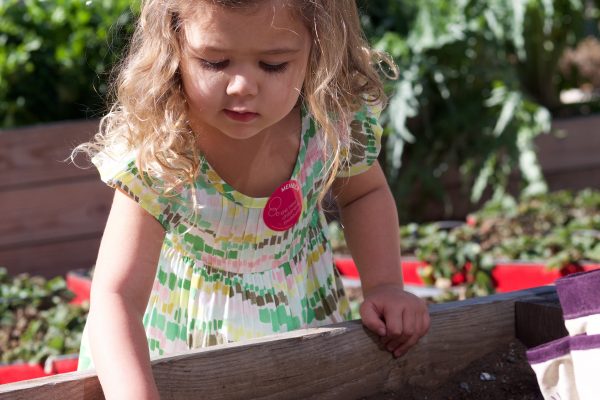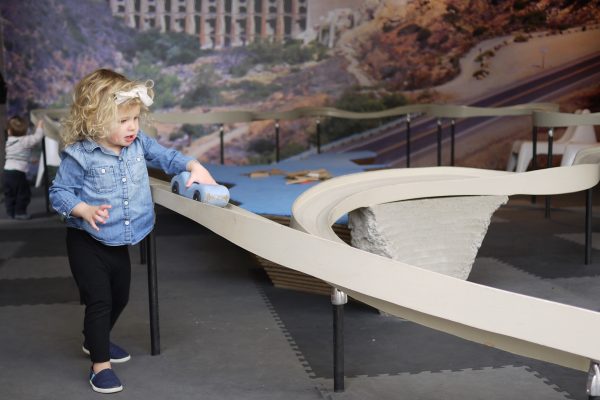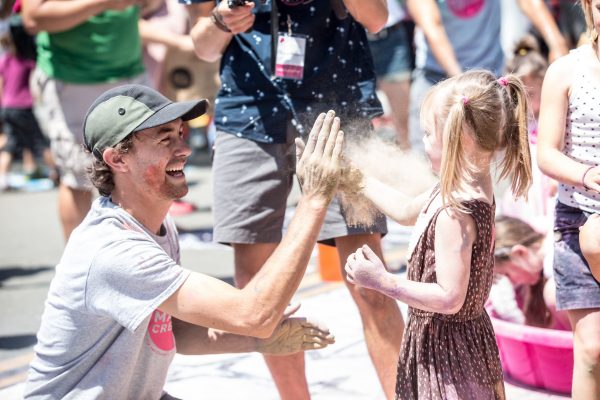Read + Create: Collectively You Portrait
Create a self-portrait on your own or with a friend in this project inspired by the children’s book, Milo Imagines the World by Matt de la Peña and illustrated by Christian Robinson. Explore collage techniques, as seen in the book, and create a unique self-portrait by layering marker and other materials on acetate that can both reveal, as well as keep hidden, elements of you and your story.
This project is designed by the Museum’s Teaching Artists and inspired by our Reading Two-Gether Author Visit series, which provides early learning literacy opportunities for children.
Collectively You Portrait Tutorial
AGE: 7+
TIMEFRAME: 1 hour (with story sharing time)
SUPPLIES NEEDED:
- Copy of Milo Imagines the World or view a virtual reading by the author here
- 1 Sheet of 8” x 11” clear acetate
- 1 Black permanent marker
- 3 Pieces of colored tissue paper
- 1 Piece of colored adhesive foam
- Scissors
- Glue stick
Directions
1. Read the Story: Start by reading Milo Imagines the World by Matt de la Peña, illustrated by Christian Robinson. This story is about Milo, a young boy who observes the world and the people around him and draws their lives. After learning more about the people he is drawing, he is surprised to learn that he has formed some wrong ideas about them. He realizes that he cannot really know anyone just by looking at them. As you read the book, think about if you have made similar assumptions about people. Were you surprised too? Have assumptions been made about you?
2. Partner Drawing: Work with a partner to create a starter portrait of yourself and them. If you don’t have a partner, you can use a mirror to look at yourself and draw what you see. With a partner, take your sheet of acetate and black permanent marker from the kit. Have your partner hold the sheet of acetate loosely up to your face. They will then carefully outline your face, eyes, nose, lips, eyebrows and hair with a marker on top of the acetate. Then, trace their face and its details on their sheet of acetate.
3. Story Sharing: While you are tracing each other’s faces, share stories and talk about assumptions you might have made about each other or that other people might make about you. For example, in the story of Milo, he imagines the young boy with the white shoes as being on a very different journey from him that day, but they turn out to have something in common. If you’re doing this part on your own, consider moments of when you were surprised to learn something about someone or when someone may have been surprised to learn something about you.
4. Add Details: Think about the features your partner decided to outline and what you want to add to complete the picture of yourself. Use the marker to add any other details that might have been missed at first but that make up you. Cut shapes from the adhesive foam and add other details and ideas to your portrait.
5. Include More: Think about 3-4 ideas that tell more about your story. They could be things you like, people you know, or memories you have. Using the marker, add drawings of your chosen images on the sheet of acetate around your portrait. Think about the 3–4 things you drew and whether you would like to share them with the world or would like to keep them to yourself. Then cover the space around your face on the portrait by gluing pieces of tissue paper around it. If you choose, cover the things you would like to keep to yourself and leave the things you would like to share with the world uncovered. You will still be able to see the parts you are keeping to yourself on the other side of the acetate sheet.
6. Share Your Portrait! Now that you have finished your portrait, share it with your family and friends. Explain to them how you made it. Was there anything that surprised you while making it? Tell them how the picture represents you, and explain some of the choices you made and new ideas you gained from it.
Additional Learning Activities (K-5)
Story Collage
Notice the illustrations in Milo Imagines the World by illustrator Christian Robinson. Robinson uses collage to make his pictures by layering paper and then drawing over it. Using that technique as inspiration, create another work of art to tell a visual story – yours or someone else’s. It may be their actual story or one that you imagine about them (as Milo does in the book). If you create a story about someone else, consider sharing it with them afterwards to learn more about them and discuss your impressions together.
Words Alive Related Resources
Words Alive, a local literacy-centered organization and partner of The New Children’s Museum, is dedicated to providing literacy education, resources and programs to families throughout San Diego and beyond. In addition to virtual readings available on their website, wordsalive.org, they have also designed a host of related projects and exercises to explore.
Enjoy Another Story
Reading is a wonderful vehicle for learning and exploring new ideas. Select engaging and age- appropriate books by the same author or those that explore similar themes, such as people, places, shared experiences and community.
Recommended Related Reading:
- Last Stop on Market Street by Matt de la Peña and illustrated by Christian Robinson
- You Matter by Christian Robinson
- Whoever You Are by Mem Fox
- Just In Case You Want to Fly by Julie Fogliano
CA Standards for Visual Arts (Grades K-5)
- Engage in exploration and imaginative play with various arts materials.
- Explore uses of materials and tools to create works of art or design.
- Use observation and investigation in preparation for making a work of art.
- Repurpose found objects to make a new artwork or design.
- Discuss and reflect with peers about choices made in creating artwork.
- Create personally satisfying artwork using a variety of artistic processes and materials.
- Discuss, reflect and add details to enhance an artwork’s emerging meaning.
- Brainstorm individual and collaborative approaches to a creative art or design problem.
- Identify, describe and visually document places and/or objects of personal significance.
This project is made possible through program funding from
